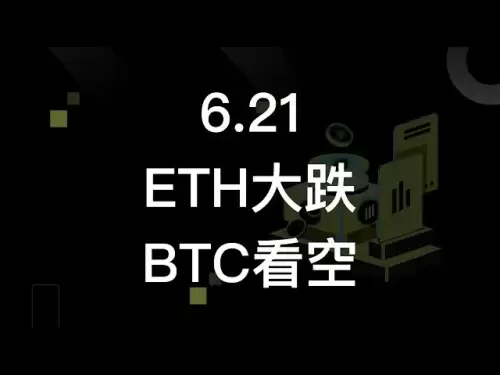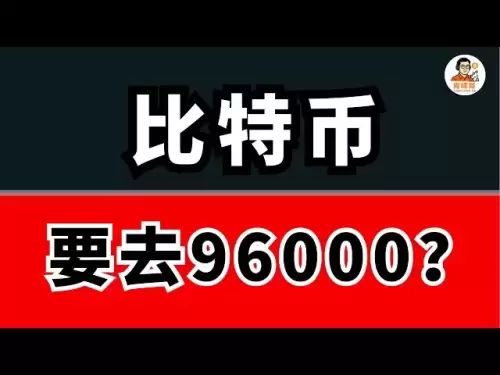-
 Bitcoin
Bitcoin $106,754.6083
1.33% -
 Ethereum
Ethereum $2,625.8249
3.80% -
 Tether USDt
Tether USDt $1.0001
-0.03% -
 XRP
XRP $2.1891
1.67% -
 BNB
BNB $654.5220
0.66% -
 Solana
Solana $156.9428
7.28% -
 USDC
USDC $0.9998
0.00% -
 Dogecoin
Dogecoin $0.1780
1.14% -
 TRON
TRON $0.2706
-0.16% -
 Cardano
Cardano $0.6470
2.77% -
 Hyperliquid
Hyperliquid $44.6467
10.24% -
 Sui
Sui $3.1128
3.86% -
 Bitcoin Cash
Bitcoin Cash $455.7646
3.00% -
 Chainlink
Chainlink $13.6858
4.08% -
 UNUS SED LEO
UNUS SED LEO $9.2682
0.21% -
 Avalanche
Avalanche $19.7433
3.79% -
 Stellar
Stellar $0.2616
1.64% -
 Toncoin
Toncoin $3.0222
2.19% -
 Shiba Inu
Shiba Inu $0.0...01220
1.49% -
 Hedera
Hedera $0.1580
2.75% -
 Litecoin
Litecoin $87.4964
2.29% -
 Polkadot
Polkadot $3.8958
3.05% -
 Ethena USDe
Ethena USDe $1.0000
-0.04% -
 Monero
Monero $317.2263
0.26% -
 Bitget Token
Bitget Token $4.5985
1.68% -
 Dai
Dai $0.9999
0.00% -
 Pepe
Pepe $0.0...01140
2.44% -
 Uniswap
Uniswap $7.6065
5.29% -
 Pi
Pi $0.6042
-2.00% -
 Aave
Aave $289.6343
6.02%
What does a sudden surge in the momentum indicator mean? Is the MOM high-level turn a signal of a peak?
A sudden surge in the MOM can signal strong buying or selling pressure in the crypto market, but traders should confirm with other indicators to avoid false signals.
May 28, 2025 at 09:49 pm
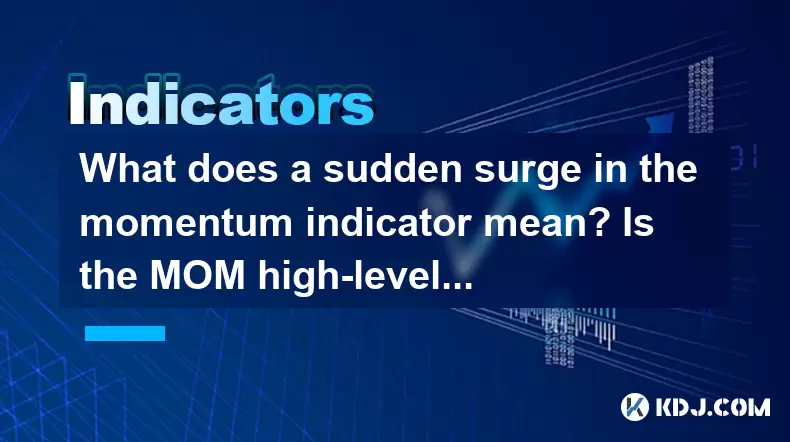
A sudden surge in the momentum indicator (MOM) within the cryptocurrency market can be a critical signal for traders and investors. Momentum indicators measure the speed or strength of a price movement over a specific period. They help traders identify potential trend reversals, continuations, or the beginning of new trends. When there is a sudden surge in the MOM, it indicates that the price is accelerating at a faster rate than before. This acceleration could be a sign of strong buying or selling pressure, depending on whether the surge is positive or negative.
In the context of cryptocurrencies, a sudden surge in the MOM can be interpreted in several ways. If the surge is upward, it might suggest that the cryptocurrency is experiencing a bullish trend with increasing buying pressure. Conversely, a downward surge could indicate a bearish trend with increasing selling pressure. Traders often use this information to make informed decisions about entry and exit points. However, it's essential to consider other technical indicators and market conditions to avoid false signals.
Understanding the Momentum Indicator
The momentum indicator is calculated as the difference between the current closing price and the closing price a specific number of periods ago. The formula for the momentum indicator is:
[ \text{MOM} = \text{Current Price} - \text{Price n periods ago} ]
Where 'n' is the number of periods chosen by the trader. For instance, if you are looking at a 10-day momentum, you would subtract the closing price from 10 days ago from the current closing price. A positive value indicates upward momentum, while a negative value indicates downward momentum.
Interpreting a Sudden Surge in MOM
A sudden surge in the MOM can be a powerful signal, but it's crucial to understand the context. For example, if a cryptocurrency has been in a steady uptrend and suddenly experiences a sharp increase in the MOM, it might suggest that the trend is gaining strength. However, if the surge occurs after a prolonged period of consolidation or a downtrend, it could indicate the start of a new bullish trend.
On the other hand, if the MOM surges downward after a period of rising prices, it could signal that the bullish trend is losing steam and a bearish reversal might be imminent. Traders need to look at other indicators, such as volume and moving averages, to confirm the signal provided by the MOM.
Is the MOM High-Level Turn a Signal of a Peak?
A high-level turn in the MOM can indeed be a signal of a peak, but it's not always a definitive indicator. When the MOM reaches a high level and starts to turn downward, it suggests that the upward momentum is waning. This can be an early warning sign that the price may soon follow suit and start to decline.
However, traders should not rely solely on the MOM to determine a peak. Other factors such as overbought conditions, divergence between the price and the MOM, and market sentiment should also be considered. For instance, if the price continues to rise while the MOM starts to decline, this divergence could be a strong indication that a peak is near.
Using MOM in Cryptocurrency Trading
To effectively use the MOM in cryptocurrency trading, traders need to follow a systematic approach. Here are some steps to consider:
- Choose the Right Timeframe: Depending on your trading strategy, you might use a shorter or longer timeframe for the MOM. Day traders might use a 5-day or 10-day MOM, while swing traders might prefer a 20-day or 30-day MOM.
- Monitor the MOM: Keep a close eye on the MOM to identify sudden surges or high-level turns. Use charting software that allows you to plot the MOM alongside the price chart.
- Confirm with Other Indicators: Always confirm the signals from the MOM with other technical indicators such as the Relative Strength Index (RSI), Moving Average Convergence Divergence (MACD), and volume indicators.
- Set Stop-Loss Orders: Given the volatility of the cryptocurrency market, it's crucial to set stop-loss orders to manage risk. If the MOM signals a potential peak, consider setting a stop-loss just below the recent high.
Practical Example of Using MOM
Let's consider a practical example to illustrate how a trader might use the MOM in the context of a cryptocurrency like Bitcoin. Suppose Bitcoin has been in a steady uptrend for several weeks, and the 10-day MOM has been consistently positive. Suddenly, the MOM surges to a new high, indicating strong buying pressure.
- Step 1: The trader observes the sudden surge in the MOM and checks other indicators like the RSI and MACD for confirmation.
- Step 2: If the RSI is not in overbought territory and the MACD confirms the bullish trend, the trader might decide to enter a long position.
- Step 3: However, a few days later, the MOM starts to turn downward from its high level. The trader monitors this closely and notices a divergence between the price and the MOM.
- Step 4: Seeing the potential peak signaled by the high-level turn in the MOM, the trader sets a stop-loss order just below the recent high to protect their profits.
Combining MOM with Other Technical Indicators
While the MOM is a valuable tool, it's most effective when used in conjunction with other technical indicators. For instance, the Relative Strength Index (RSI) can help identify overbought or oversold conditions. If the RSI is above 70 (overbought) and the MOM shows a high-level turn, it strengthens the case for a potential peak.
Similarly, the Moving Average Convergence Divergence (MACD) can provide additional confirmation. If the MACD line crosses below the signal line while the MOM is turning downward, it reinforces the bearish signal. Volume indicators can also be crucial; a high-level turn in the MOM accompanied by decreasing volume might suggest that the price rally is losing steam.
Frequently Asked Questions
Q1: How can I adjust the MOM to suit different trading strategies?
A1: To adjust the MOM for different trading strategies, you can change the number of periods used in the calculation. Shorter periods like 5 or 10 days are suitable for day trading, providing more sensitive signals. Longer periods like 20 or 30 days are better for swing trading, offering more stable signals. Experiment with different periods to find what works best for your strategy.
Q2: Can the MOM be used for all cryptocurrencies, or is it better suited for certain types?
A2: The MOM can be used for all cryptocurrencies, but its effectiveness may vary depending on the liquidity and volatility of the specific cryptocurrency. More liquid and less volatile cryptocurrencies like Bitcoin and Ethereum might provide more reliable MOM signals. Less liquid and more volatile altcoins may produce more false signals, so it's essential to use the MOM in conjunction with other indicators.
Q3: How often should I check the MOM to make informed trading decisions?
A3: The frequency of checking the MOM depends on your trading style. Day traders might need to check the MOM multiple times a day, especially during active trading sessions. Swing traders might check the MOM daily or weekly. It's important to set alerts for significant changes in the MOM to stay informed without constantly monitoring the charts.
Q4: Are there any common pitfalls to avoid when using the MOM in cryptocurrency trading?
A4: One common pitfall is relying solely on the MOM without confirming signals from other indicators. Another is misinterpreting a sudden surge in the MOM as a definitive signal without considering the broader market context. Additionally, traders should avoid chasing after a surge in the MOM without a solid risk management strategy in place, as the cryptocurrency market can be highly volatile.
Disclaimer:info@kdj.com
The information provided is not trading advice. kdj.com does not assume any responsibility for any investments made based on the information provided in this article. Cryptocurrencies are highly volatile and it is highly recommended that you invest with caution after thorough research!
If you believe that the content used on this website infringes your copyright, please contact us immediately (info@kdj.com) and we will delete it promptly.
- Pi Coin Price Bulls: Navigating the Crossroads After Mainnet Launch
- 2025-06-21 18:45:12
- ZachXBT, Bitcoin Bridges, and Garden Finance: A Deep Dive
- 2025-06-21 18:25:11
- BTC Recovery, Bearish Sentiment, and Trader Impatience: Navigating the Crypto Maze
- 2025-06-21 18:25:11
- SUI Price Wobbles Amid Crypto Slump: Opportunity or Omen?
- 2025-06-21 18:45:12
- Worldcoin Price Prediction: Will WLD Stage a Comeback?
- 2025-06-21 19:05:11
- Cardano's Crossroads: Market Sentiment, Slides, and a Glimmer of Hope
- 2025-06-21 19:05:11
Related knowledge

Does the sudden contraction of ATR indicate the end of the trend?
Jun 20,2025 at 11:14pm
Understanding ATR and Its Role in Technical AnalysisThe Average True Range (ATR) is a technical indicator used to measure market volatility. Developed by J. Welles Wilder, ATR calculates the average range of price movement over a specified period, typically 14 periods. It does not indicate direction—only volatility. Traders use ATR to gauge how much an ...

Is it invalid if the DMI crosses but the ADX does not expand?
Jun 21,2025 at 09:35am
Understanding the DMI and ADX RelationshipIn technical analysis, the Directional Movement Index (DMI) consists of two lines: +DI (Positive Directional Indicator) and -DI (Negative Directional Indicator). These indicators are used to determine the direction of a trend. When +DI crosses above -DI, it is often interpreted as a bullish signal, while the opp...

Is the trend continuation when the Williams indicator is oversold but there is no rebound?
Jun 20,2025 at 11:42pm
Understanding the Williams %R IndicatorThe Williams %R indicator, also known as the Williams Percent Range, is a momentum oscillator used in technical analysis to identify overbought and oversold levels in price movements. It typically ranges from 0 to -100, where values above -20 are considered overbought and values below -80 are considered oversold. T...
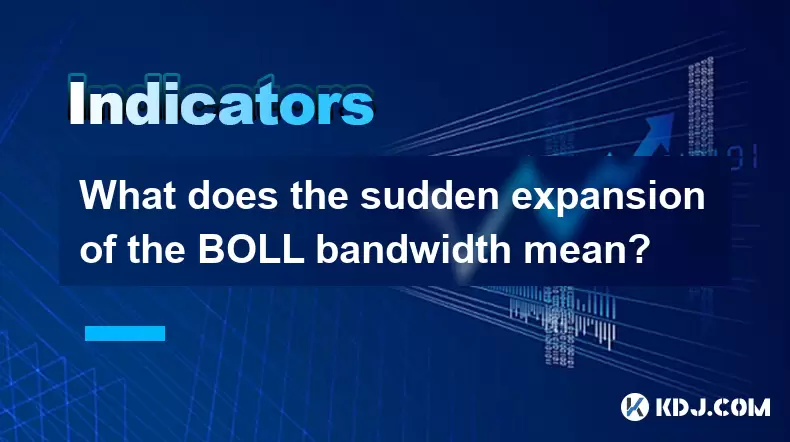
What does the sudden expansion of the BOLL bandwidth mean?
Jun 21,2025 at 01:49pm
Understanding the BOLL IndicatorThe BOLL (Bollinger Bands) indicator is a widely used technical analysis tool in cryptocurrency trading. It consists of three lines: a simple moving average (SMA) in the center, with upper and lower bands calculated based on standard deviations from that SMA. These bands dynamically adjust to price volatility. When trader...

Is the golden cross of the ROC indicator below the zero axis effective?
Jun 20,2025 at 09:42pm
Understanding the ROC Indicator and Its Role in Cryptocurrency TradingThe Rate of Change (ROC) indicator is a momentum oscillator widely used by traders to assess the speed at which cryptocurrency prices are changing. It measures the percentage difference between the current price and the price from a certain number of periods ago. The ROC helps identif...
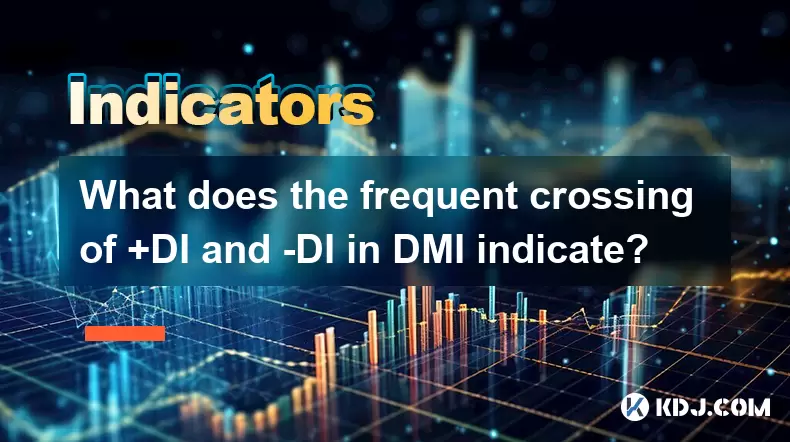
What does the frequent crossing of +DI and -DI in DMI indicate?
Jun 21,2025 at 05:14pm
Understanding the DMI and Its ComponentsThe Directional Movement Index (DMI) is a technical analysis tool used to identify the strength and direction of a trend. It consists of two lines: +DI (Positive Directional Indicator) and -DI (Negative Directional Indicator), along with the ADX (Average Directional Index) line which measures trend strength. In cr...

Does the sudden contraction of ATR indicate the end of the trend?
Jun 20,2025 at 11:14pm
Understanding ATR and Its Role in Technical AnalysisThe Average True Range (ATR) is a technical indicator used to measure market volatility. Developed by J. Welles Wilder, ATR calculates the average range of price movement over a specified period, typically 14 periods. It does not indicate direction—only volatility. Traders use ATR to gauge how much an ...

Is it invalid if the DMI crosses but the ADX does not expand?
Jun 21,2025 at 09:35am
Understanding the DMI and ADX RelationshipIn technical analysis, the Directional Movement Index (DMI) consists of two lines: +DI (Positive Directional Indicator) and -DI (Negative Directional Indicator). These indicators are used to determine the direction of a trend. When +DI crosses above -DI, it is often interpreted as a bullish signal, while the opp...

Is the trend continuation when the Williams indicator is oversold but there is no rebound?
Jun 20,2025 at 11:42pm
Understanding the Williams %R IndicatorThe Williams %R indicator, also known as the Williams Percent Range, is a momentum oscillator used in technical analysis to identify overbought and oversold levels in price movements. It typically ranges from 0 to -100, where values above -20 are considered overbought and values below -80 are considered oversold. T...

What does the sudden expansion of the BOLL bandwidth mean?
Jun 21,2025 at 01:49pm
Understanding the BOLL IndicatorThe BOLL (Bollinger Bands) indicator is a widely used technical analysis tool in cryptocurrency trading. It consists of three lines: a simple moving average (SMA) in the center, with upper and lower bands calculated based on standard deviations from that SMA. These bands dynamically adjust to price volatility. When trader...

Is the golden cross of the ROC indicator below the zero axis effective?
Jun 20,2025 at 09:42pm
Understanding the ROC Indicator and Its Role in Cryptocurrency TradingThe Rate of Change (ROC) indicator is a momentum oscillator widely used by traders to assess the speed at which cryptocurrency prices are changing. It measures the percentage difference between the current price and the price from a certain number of periods ago. The ROC helps identif...

What does the frequent crossing of +DI and -DI in DMI indicate?
Jun 21,2025 at 05:14pm
Understanding the DMI and Its ComponentsThe Directional Movement Index (DMI) is a technical analysis tool used to identify the strength and direction of a trend. It consists of two lines: +DI (Positive Directional Indicator) and -DI (Negative Directional Indicator), along with the ADX (Average Directional Index) line which measures trend strength. In cr...
See all articles























